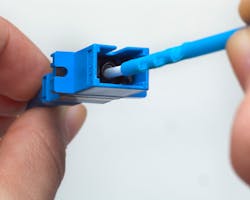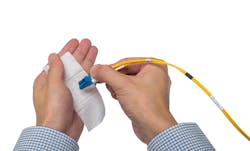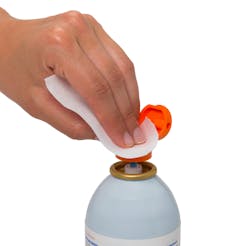By Jay Tourigny,
Static is an invisible hazard to fiber-optic networks. Electrostatic charges draw and hold unwanted dust particles onto fiber network connector endfaces just like a magnet. Although this dust contamination is merely microns in size and only visible when magnified with an inspection scope, it can still cause serious performance problems for a network. Dust in a signal’s path may change or obstruct the light’s index of refraction, or the route of the signal, through the fiber. This causes insertion loss that weakens the signal and slows down the network speed. And if the refraction angle is altered enough, the network signal may be lost altogether.
Modern fiber networks are especially susceptible to this problem because the higher the light frequency, the greater its sensitivity to changes of the refractive angle. This means faster networks like 5G, that need every milliwatt of power to function flawlessly, are more vulnerable to static and the resulting dust contamination. Therefore, it is critical to remove static and dust from fiber endfaces to help networks run faster and more reliably.
Friction: Where the static comes from
Anytime there is contact friction on a fiber endface or its ferrule, an electrostatic charge is generated. Typical fiber endfaces are made of nonconductive materials such as plastic, ceramic, glass and epoxies. Therefore, the static charge doesn’t have a path to ground and the charge cannot dissipate. The technical term for this is “triboelectric charging.” As a result, the endface stays electrostatically charged and attracts oppositely charged dust particles onto the connector. Dust clings to both the outer regions of the connector and at the ferrule apex in the contact zone. To complicate matters, the endface is often engineered with a convex geometry to minimize back reflection, but that design actually encourages static charges to concentrate at the contact region of the mated pair, actively encouraging particle migration to right where it will do the most damage. Static on endfaces is generated by contact friction in a number of ways including the following.
Dry wiping: One of the most common sources of contact friction from static comes from wiping a nonconductive endface with a dry wipe or cleaning stick. The wiping action creates a triboelectric charge that attracts unwanted airborne dust to the connector face. Also, a poorly engineered wipe will shed clouds of particles during cleaning, adding dust to the equation. This static buildup is especially intensified in low-humidity environments.
Air cleaning or drying: Another source of friction is cleaning or drying an endface with compressed air or canned dusters. The rapidly moving air creates friction and delivers an electrostatic charge to the endface.
Connector mating: Inserting or removing an endface connector into the adapter during mating creates static and produces wear debris including dust and other particles.
Removing protective caps: Removing manufacturer-installed protective end caps from a new endface connector, which was perfectly clean during the last inspection at the factory, will generate static and attract contamination to the endface when the end cap is removed by the installer in the field.
Network testing: Connecting an endface to an inspection scope, power meter or light source creates friction. In addition, those testing tools are almost always dirty, meaning they will cross-contaminate the endface.
Minimize static during network installation
Dust particles stay electrically bonded to a cable endface until the static charge is dissipated through proper cleaning. Therefore, the best way fiber installers can remove static and dust from a fiber network is to properly clean the fiber endfaces during installation. There are a number of recommended cleaning tools and methods that are effective at controlling static charges and meet the IEC 6130-30-35 standard for fiber endface cleanliness. They include wet/dry cleaning and static-dissipative cleaning fluid.Wet/dry cleaning is best for dissipating static. Wiping an endface with a dry wipe, dry cleaning stick, or dry clicker tool generates a significant static charge, which in turn attracts dust that is extremely difficult to dissipate. Therefore, “wet/dry” cleaning is recommended by both IPC (Institute of Printed Circuits) and iNEMI (international Electronics Manufacturing Initiative) to reduce static and meet the IPC-8497-1 fiber-optic cleaning standard. Wet/dry cleaning increases the humidity on the endface and dissipates the surface static. During the wet/dry cleaning process, an installer uses a section of an optic-grade cleaning wipe, dampened with a static-dissipative cleaning fluid. The installer wipes the connector endface starting at the damp area and moving in one direction toward the dry area of the cleaning wipe. This removes the contamination and minimizes the static charge in one step. In the case of port cleaning sticks or clicker devices, the cleaning stick or device is dampened with a cleaning fluid first and then used to clean the endface.
Static-dissipative cleaning fluid. Dust remains bonded to an endface until the static charge finds a conductive path for it to dissipate. The introduction of a static-dissipating cleaning fluid temporarily creates that conductive path for the static to disperse, making it easy to physically wipe the debris away. An optical-grade cleaning fluid that is engineered specifically for cleaning fiber-optic endfaces is the best choice. The cleaning fluid should be ultra-pure, residue-free and nonflammable. It should also be in a hermetically sealed (un-refillable) container to prevent cross-contamination and spilling. Using a fast-drying, static-dissipative fluid also eliminates any additional drying step, saving time.
Avoid IPA
Some fiber installers use isopropyl alcohol (IPA) to clean fiber endfaces. However, IPA is hygroscopic, meaning it absorbs moisture out of the air. As the IPA absorbs the water molecules, it also picks up airborne microscopic dust particles such as exhaust particles from traffic, pollen from plants, construction dust and absorbed minerals and salts from the water molecules. In addition, IPA is slow-drying. In some instances, an installer might use an aerosol duster to speed up the drying. However, this increases the static charge, attracting more dust. Plus, IPA is very flammable, making it regulated as dangerous goods for transportation.
Cleaning sticks. The combination of a cleaning stick and static-dissipating cleaning fluid are perfect for cleaning and removing static from connectors mounted in hard-to-clean alignment sleeves. When cleaning, an installer dampens the cleaning stick with cleaning fluid first. After inserting the stick into the connector, they rotate it about six times in the same direction. They avoid extreme force and do not excessively scrub the endface to prevent scratching, pitting or scarring endfaces. A cleaning stick should be engineered specifically to match the configuration of the endface and be non-linting for optimal cleaning.A well-engineered cleaning stick will also make incidental contact with the alignment-sleeve sidewalls, allowing fluid from the cleaning stick to contact the sidewalls and instantly defuse static charges so debris that exists on the alignment sleeve stays put, and does not jump onto the clean connector endface during insertion.
Cleaning sticks should be kept in their package until ready to use to prevent soiling or damage. Also, cleaning sticks are single-use. Reusing the same stick spreads contamination from on endface to the other. In addition, all connectors should be cleaned, both sides, every time before mating them to prevent cross-contamination.
High-grade optical wipes. Less-expensive wipes are rarely up to the task of cleaning microscopic contamination from optical connectors. They tend to rip and shred easily, leaving lint and debris behind and often generate high static charges, making their use counterproductive. In the case of optical wipes, the adage “you get what you pay for” very often is true. Therefore, high-grade, optical-grade wipes that do not lint and do not generate static charges are the preferred choice.
Economize by purchasing smaller-sized wipes that reduce waste. Look for a wipe sold in packaging engineered to minimize static charges as individual wipes are dispensed.
Also, leaving the wipes in the packaging until ready to use ensures they stay clean, preventing waste. Like the cleaning sticks, wipes should be used only once and then thrown away to prevent cross-contamination on the network endfaces.
In conclusion, static is a threat to fiber-optic network performance. Triboelectric charges attract dust particles to the endfaces and lock them in place. Dust contamination on the core of the fiber, which is the part of the fiber that the signal travels through, can cause insertion loss, impacting network speeds. In addition, the dust particles can be ground into the ferrule face, causing pits and scratches, which might require complete endface replacement. Therefore, it is important to eliminate static to help improve endface cleaning and overall fiber network performance.
Dry cleaning creates a static charge on connector endfaces. Therefore, wet/dry cleaning is recommended. A modern, water-free, high-purity fluid engineered for cleaning fiber-optic connectors will both dissipate and prevent triboelectric charges in the connector endface.
In addition, the proper use of high-quality cleaning sticks and optical-grade cleaning wipes on both ends of the connectors prior to mating will deliver cleaner endfaces and ultimately a more-robust network.
Those looking for help in cleaning and removing static from their fiber-optic endfaces should work with a company that has experience and expertise in fiber-optic cleaning. They can recommend the best fluids, tools and methods for each individual cleaning challenge.
Jay Tourigny is senior vice president at MicroCare Corp., which offers Sticklers brand fiber-cleaning solutions. He has been in the industry for more than 30 years, and holds numerous U.S. patents for cleaning-related products that are used on a daily basis in fiber-optic, medical and precision cleaning applications.


